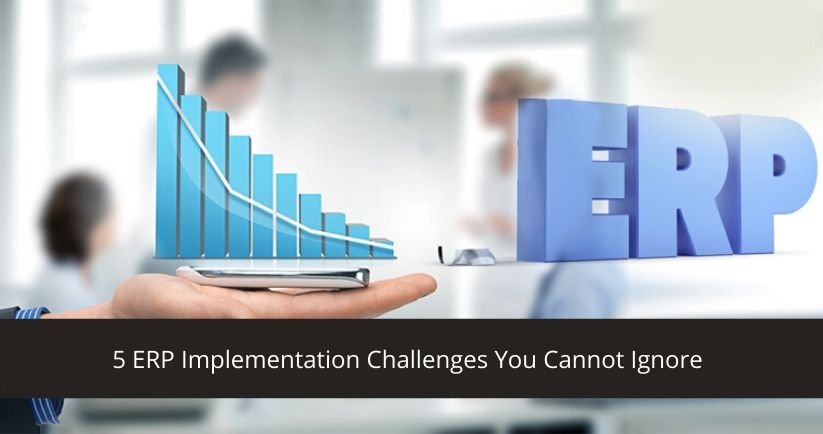ERP Implementation Challenges in Manufacturing
ERP implementation challenges is one of the most daunting questions businesses have to face. Plus, getting it wrong is no less than a nightmare for any business. Thus, it is advisable to keep ERP implementation under proper control for a smooth and successful embracement of the same all across the organisation.
Enterprise Resource Planning (ERP) rests at the core of any business. ERP software helps enterprises carry out seamless operations across multiple departments – finance, accounting, inventory, supply chain, human resources and other business functionalities. ERP software is a suite of integrated applications, which can collect, store, organize and understand the data from multiple business functions. ERP solutions can be deployed On-Cloud or On-Premise depending upon the goals and needs of individual organization. On-Cloud ERP software solutions have gained momentum in recent years given its benefits of cost cuts on infrastructure and resources. On-Cloud ERP implementation involves hosting the data on cloud at the vendor’s premises. This can help companies save money being invested on IT infrastructure and resources to manage and maintain those.
Why Traditional Manufacturing Planning is falling out of Use?
Since the 1960s, companies have been relying on MRP technology for handling inventory management software. Its forecasting abilities have found tremendous applications in the manufacturing industry but there should be no qualms in accepting that its advantages have been far blown out of proportion in contemporary times. This article talks about why traditional planning is falling out of use and why manufacturing ERP needs a complete reformation.
Reasons why traditional manufacturing planning is falling out of use:
- It relies heavily on forecasting.
- Forecasting helps estimate sales, production costs, and inventory planning.
- But forecasting can only provide a rough estimate and in most cases, the figures are too ideal to achieve.
- Forecasting takes into account past sales data, material batch sizes, and wasted resources.
- If there is even a small error in the data, it can lead to the generation of erroneous reports that ultimately defeat the purpose of the forecast.
- Also, as material lead times continue to get shorter, it is getting even more difficult to forecast.
Also Read: Benefits of Material Management in ERP
How traditional planning is transforming?
- MRP (Material Requirements Planning) is slowly and steadily changing to DDMRP (Demand Driven Material Requirements Planning).
- DDMRP brings a new element in production planning – variability.
- This is why planners need not be too precise and give suitable weightage to uncertainty in the planning process.
- Instead of a due date system, DDMRP uses a buffer status system to determine priority.
- For example, if a manufacturing company has a buffer stock of 20% aluminium and the due date is 5 weeks away, then a DDMRP will assign a higher priority to it than if the same manufacturing company has a buffer stock of 50% iron and the due date is 3 weeks away. This results in better production planning, material handling, and inventory management.
Taking a demand-driven approach instead of a due date approach is the need of the hour. Meeting modern market needs requires important adjustments such as close monitoring of buffer levels and strategic decoupling.
Here is a checklist of some of the biggest challenges faced by businesses of all sizes when implementing ERP solutions.
1. Selection challenges
When deciding to have an ERP solution on-board, the foremost question to pop-up in the heads of managers and CXOs is to decide the type, scope, scalability and size of the ERP software as well as ensure that it suits the company’s budget, preferences and industry needs. Then follows a streak of consulting and research work to find the best ERP software. This hurdle is faced by all businesses and it needs to be addressed with a sound and insightful approach. ERP is not an instant thing, and as it has a great impact on a business for years to come thus, being cautious from the start can save businesses from remorse.
2. Technical challenges
Post selection comes the technical roadblock, which might summon for revamping servers, workstations and other traditional management systems in an organisation. In fact, the entire internal network needs monitoring and inspection to check for compatibility with the soon to be implemented ERP software. Overlooking these technical aspects might result in a huge disaster hindering smooth use of the system. Sage Software Solutions Pvt. Ltd., a leading provider of business management solutions to SMEs and start-ups in India suggests going with a SaaS (Software-as-a-Service) ERP software for SME, since it is budget-friendly and hassle-free.
3. Data quality challenges:
It is one of the common challenges for companies that are plunging in for the first time, i.e. first time ERP implementation. Here, businesses reinstate a legacy enterprise resource planning system with a modern and advanced ERP solution. Here comes the big hurdle, data generated through legacy system might not be compatible with the new system. This calls for ample of project planning well before the actual implementation to avoid the legacy vs. new system tussle. Meticulous project planning before rolling out the software gives a clear picture of all the potential modifications that the system would require to work seamlessly. Sage Software advises to always a conduct a pilot test of the software before actually getting it on-board.
4. Managerial challenges
ERP implementation triggers substantial changes in an organisation’s traditional business conducts, model and practices. With a new ERP system in place, information keyed-in by one user is instantaneously available to other users, and that too in real-time. This greatly lifts the responsibility bar for every user. Thus, there is a strong need to introduce new managerial practices and principles. Also, steps should be taken to revamp or revise existing practices and make them compatible with the new system. Though it is one of the serious challenges, it renders a fantastic opportunity for companies to get rid of conventional business practices to pave way for a quick and intelligent enterprise resource planning solution.
5. Psychological challenges
This is the most difficult challenge to overcome. Since humans are resistant to change, there would be questions, issues and many hesitant or disinterested faces in your company to embrace the newly implemented ERP system. In fact, it becomes difficult to predict every potential concern or difficulties in this regard. Thus, it is advisable to rope in every employee right from the start i.e., from planning to selection of the ERP solution. The best a project manager can do is to keep employees excited about the system in advance explaining the benefits of how it can make things easier for them. Further, having one-to-one communications can help in curbing the ‘resistance to change’ epidemic within an organisation to a significant extent.
3 Ways Manufacturing Scheduling in ERP Systems Increases Efficiency
Are you unable to keep up with customer demands? Are you finding it difficult to meet delivery requirements? Is factory planning – resource allocation, production capacity, material scheduling, inventory costs, employee activity – a major challenge for you? If the answer to all those questions is a resounding yes, then you should plan to invest in a manufacturing ERP with manufacturing scheduling capabilities.
This article throws light on 3 ways how manufacturing scheduling in ERP systems increases efficiency.
What are the features of Manufacturing scheduling?
- Uses a color code system to schedule activities
- Updates material lead times
- Increases plant floor throughput
- Uses drag and drop method to efficiently reschedule activities
- Prioritizes jobs taking market demand into consideration
How manufacturing scheduling in ERP systems helps increase efficiency?
1. Brings the power of integration to a single platform
-
- You no longer require whiteboards, spreadsheets and any other kind of analog data management system to store business-critical data.
- You can gain access to vital information from a single platform at the touch of a button.
- Manufacturing ERP mitigates information silos by allowing data to be shared with employees across each department.
- This data can be used to create and update customer profiles, keep a close watch over factory throughput, monitor quality control, check the availability of raw materials, vendor management, manufacturing time, etc.
2. Eliminates planning errors
-
- Apart from monitoring manufacturing assembly lines, a manufacturing ERP also needs to take into account other factors such as shipment dates, inventory management, and items manufactured by sub-assemblies and third-party vendors.
- Manufacturing scheduling in ERP systems stores accurate data for the parameters mentioned in the previous point.
- This removes inaccuracies and eliminates planning errors.
3. Has forecasting and streamlining capabilities
-
- Manufacturing scheduling does real-time adjustments to handle unforeseen events.
- It enables manufacturing ERP to forecast sales orders, resources required, and costs to be borne based on real-time data.
- It can be easily integrated with Warehouse Management System (WMS) and streamline various important activities such as organizing, planning, staffing, and managing resources.
Manual production techniques pose myriad challenges. They fail to offer a comprehensive solution that can integrate all systems into one platform, eliminate planning errors, and forecast market demand.
What are the advantages of using MRP and MPS in ERP Systems?
Are you facing problems in production planning? Is inventory scheduling eating up a lot of time? Has the process of material management got the best of you? If yes, then you require an ERP software with an integrated MRP system. This article elaborates on how MRP enabled ERP software provides a comprehensive solution to manage increased demands.
What is the difference between MRP and MPS ?
First of all, it is necessary to understand the difference between these two terms.
MPS
- It stands for Master Production Schedule.
- It is concerned with the production of items that have independent demand.
- MPS items are demanded by customers or are manufactured keeping forecasted requirements in mind.
- For example, a pen has market demand. Therefore, a pen is an MPS item.
MRP
- It stands for Material Requirements Planning.
- It is concerned with the production of items that have dependent demand.
- MRP items are not demanded by customers but they are essential to manufacturing MPS items.
- For example: While manufacturing a pen; the barrel, spring, cap, and refill are the four items that are required to produce a pen. So, these four items are MRP items.
At the conceptual level, the differences between MPS and MRP have been listed above. Although they serve different purposes, the functions executed by them are the same.
3 Advantages of using MRP in ERP systems to meet increased demands
1. Planning and control
-
- Uses data to determine the cost and quantity of inventory required for manufacturing purposes.
- It helps reduce inventory carrying costs.
- Administrates the production process by examining what to buy, when to buy, and how much to buy.
- Counter checks whether the production schedule is going as planned.
- Automatically places orders if there is a shortage of required materials.
- Detects bottlenecks and reorganizes the production line accordingly.
2. Resource management and Scheduling
-
- Measures the time taken to manufacture products.
- Estimates the anticipated yield.
- Allows managers to forecast the labor time and cost associated with it, and products manufactured per hour.
- Monitors the availability of raw materials.
- Sends alerts to the manager regarding the need for an important equipment/material, if required.
3. Data management
-
- MRP enabled ERP software systems can generate, store, analyze, and present huge swathes of data.
- It does this by transforming inventory data information into easy-to-read invoices and receipts.
For the efficient functioning of the production department, an MRP enabled ERP software system is a boon. It helps to execute a full-fledged production planning system, manage and schedule resources, and control data to meet increasing demands.
So now you know about all the biggest challenges that play spoilsport when it comes to a smooth and company-wide ERP implementation, it is time to mull-over these roadblocks well beforehand and equip yourself with all that is needed to steer clear these barriers.
Regardless of the industry segment you are operating in, ERP software will be extremely beneficial to your business. Some of the industries that do not fail to implement ERP solutions are –
- Manufacturing
- Retail
- Pharma Trading
- Chemical
- Ecommerce
- Supply Chain
- Packaging
- Real Estate
- Finance
- Media & Advertisement
- Plan Manufacturing
- Alcohol & Distilleries
Above are just a few industry segments to name from the myriad business operations being carried out across eclectic sectors. ERP software will automate the mundane business tasks while offer real-time data that will help you save not only on cost and resources, but also focus on core business operations involved in driving growth and profitability.
At Sage Software, we are home to world-class Manufacturing ERP software that automates scheduling and increases efficiency exponentially. To know more about it, You can also write to us at sales@sagesoftware.co.in.
Disclaimer: All the information, views and opinions expressed in this blog are those of the authors and their respective web sources and in no way reflect the principles, views or objectives of Sage Software Solutions (P) Ltd.





